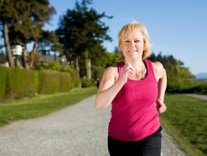
iStockphoto
Moderate exercise may help people cope with anxiety and stress for an extended period of time post-workout, according to a study by kinesiology researchers in the University of Maryland School of Public Health published in the journal Medicine and Science in Sports and Exercise.
“While it is well-known that exercise improves mood, among other benefits, not as much is known about whether these positive effects endure when we’re faced with everyday stressors once we leave the gym,” explains Dr. J. Carson Smith, the study author and an assistant professor in the Department of Kinesiology. “We found that exercise helps to buffer the effects of emotional exposure. If you exercise, you’ll not only reduce your anxiety, but you’ll be better able to maintain that reduced anxiety when confronted with emotional events.”
Smith, whose research explores how exercise and physical activity affect brain function, aging and mental health, compared how moderate intensity cycling versus a period of quiet rest (both for 30 minutes) affected anxiety levels in a group of healthy college students. He assessed their anxiety state before the period of activity (or rest), shortly afterward (15 minutes after) and finally after exposing them to a variety of highly arousing pleasant and unpleasant photographs (from the International Affective Picture System), as well as neutral images. Smith found that exercise and quiet rest were equally effective at reducing anxiety levels initially. However, once they were emotionally stimulated for ~ 20 minutes, the anxiety levels of those who had simply rested went back up to their initial levels, whereas those who had exercised maintained their reduced anxiety levels. The study findings suggest that exercise may play an important role in helping people to better endure life’s daily anxieties and stressors.
Learn more about Dr. J. Carson Smith’s research.
The article “Effects of Emotional Exposure on State Anxiety after Acute Exercise” was written by J. Carson Smith and published online ahead of print on August 14, 2012 in the journal Medicine and Science in Sports and Exercise. Download a PDF of the article at: http://www.exerciseforbrainhealth.com/publications
